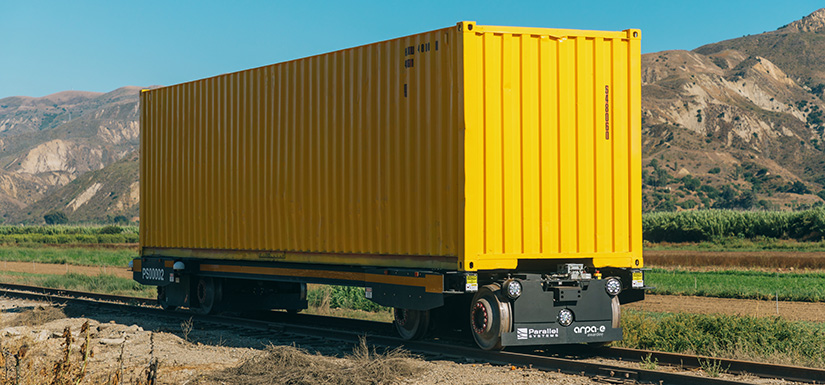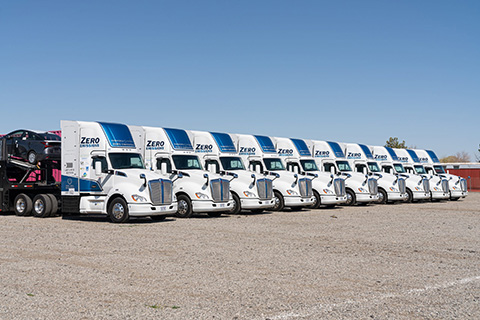Freight Transportation
NLR researchers create breakthrough tools to inform the development and deployment of cost-effective and resilient freight transportation strategies.

A significant portion of the United States' energy consumption is dedicated to freight transportation. Significant cost and energy savings can be realized through advanced freight vehicles and optimized logistics.
NLR researchers are world leaders in advanced freight transportation technologies and efficiency strategies. We build pioneering modeling and analysis tools that guide owners, operators, and decisionmakers toward cost-effective resilient freight transportation on a national scale.
Heavy-Duty Fleet Electrification

We have built the most comprehensive software tool available to evaluate the electrification potential and infrastructure requirements for fleets of commercial vehicles.
The HEVII: Heavy-Duty Electric Vehicle Integration and Implementation tool assesses the suitability for electrification of each individual vehicle within a fleet, determines optimal locations for charging infrastructure to support a fleet of electric trucks, and analyzes associated costs. Researchers can then provide customized specifications and recommendations for optimal vehicle battery sizes, charging rates, and infrastructure placement.
HEVII enables NLR researchers to provide tailored, cost-effective strategies to shift diesel-fueled medium- and heavy-duty fleets to next-generation models.
HEVII is informed by NLR's FleetREDI: Fleet Research, Energy Data, and Insights platform, the world's only secure, public, and anonymized data analysis and insights pipeline for commercial vehicles.
Freight Rail Improvements

Moving freight by rail is the most cost-effective method to move large amounts of cargo over land and, by freight ton-mile, can be up to four times more fuel-efficient than truck transit. Further advancements can realize even greater cost savings through reductions in energy and fuel use.
NLR researchers have built the world's first fully integrated, open-source software to optimize energy-impacting aspects of rail operation. The ALTRIOS: Advanced Locomotive Technology and Rail Infrastructure Optimization System is a simulation and optimization software tool capable of delivering tailored strategies for gradually phasing in advanced locomotive technologies and the associated infrastructure needed to achieve energy and fuel savings, all while minimizing scheduling impacts.
ALTRIOS can help railroads design and optimize a gradual transition to higher-performing technologies, custom-built for real-world operations.
National Intermodal Freight Modeling
NLR researchers are leading the charge to develop the first-ever national intermodal freight modeling framework. Called INFORMES: the INtermodal Freight Optimization for a Resilient Mobility Energy System, it will guide optimized intermodal freight operations that can support greater reliability across the nation’s freight system.
The tool will capture the complex interplay of technologies, infrastructure, and freight traffic at a national level. INFORMES will be capable of simulating the movements of on-road trucks, freight trains, and vessels as well as container transshipment processes at logistics hubs, such as inland rail terminal and ports. It can then estimate the energy demand of moving containers over the entire intermodal transportation network. Using its simulation capability, researchers will be able to model how to optimize intermodal freight operations inclusive of traffic and unforeseen events and route freight shipments with greater reliability.
It will be the first tool in the nation capable of designing a resilient freight system at the national scale.
Regional Freight Modeling
Because local and regional freight delivery often involves shorter driving distances, recurring routes, and multiple loading and unloading stops which provide opportunities for recharging and refueling, it presents some of the most immediate opportunities to integrate advanced vehicle technologies.
NLR researchers build and apply novel simulation and modeling tools to analyze the potential for vehicle electrification, charging siting, innovative first- and last-mile delivery solutions, and operational efficiencies for local and regional freight movement. The FAMOS: Freight Activity MObility Simulator tool allows researchers to simulate the interplay of freight vehicle movement, shipping demand, and supply chain logistics in a region. Using the FRISM: FReight Integrated Simulation Model on GitHub, a sub-module of FAMOS, researchers can model and analyze the impacts of online shopping behavior and goods delivery by freight vehicles on day-to-day freight movement.
Together, these tools provide critical insights to inform freight optimization strategies for cities and transportation hubs.
Streamlined Freight Operations
Operational efficiencies can create significant cost savings for freight transportation stakeholders.
NLR researchers partner with trucking fleets to optimize their performance. They match the powertrain of best fit to a fleet's performance requirements, analyze vehicle operations for reduced-fuel routing and driver improvement opportunities, and provide fleet operation plans to help owners and operators understand and maximize vehicle performance. Using FRISM, NLR researchers provide fleets with last-mile delivery simulations, which can also inform cost-effective operations.
Data and Tools
The following NLR data and tools support fleet and freight research.
ALTRIOS: Advanced Locomotive Technology and Rail Infrastructure Optimization System
FleetREDI: Fleet Research, Energy, Data and Insights
FRISM: Freight Integrated Simulation Model (GitHub)
HEVII: Heavy-Duty Electric Vehicle Integration and Implementation Tool
INFORMES: INtermodal Freight Optimization for a Resilient Mobility Energy System
Publications
INFORMES: INtermodal Freight Optimization for a Resilient Mobility Energy System, ARPA-E Presentation (2024)
Emerging Trends in Freight, NLR Presentation (2023)
Development of a Heavy-Duty Electric Vehicle Integration and Implementation (HEVII) Tool, SAE 2023 World Congress Experience (2023)
ALTRIOS - Advanced Locomotive Technology and Rail Infrastructure Optimization System, NLR Presentation (2022)
Co-Optimization of Vehicles and Routes (COVAR): To Improve Commercial Transportation System Efficiency, PACCAR Technical Center Presentation (2021)
Contact
To learn more about our heavy-duty fleet and freight transportation research or to explore partnership opportunities, please reach out.
Share
Last Updated Dec. 6, 2025
